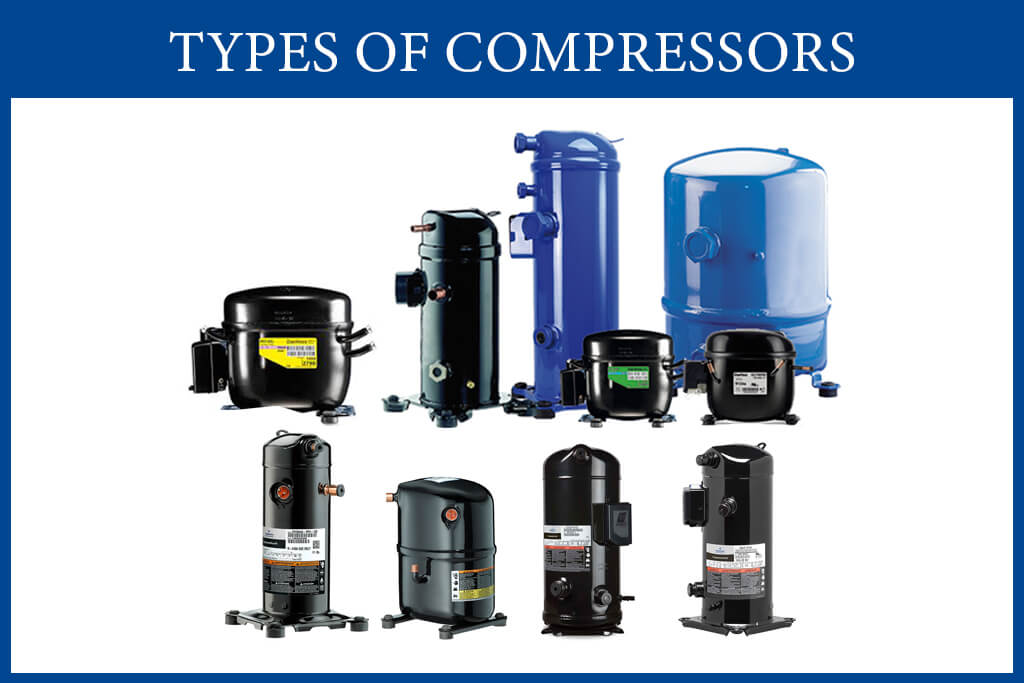The compressor in an air conditioner squeezes the refrigerant gas and sends it back through the system. The compressor transforms low-pressure refrigerant gas into high-pressure gas. It helps make cool air that is sent throughout the building. The compressor must work well for an air conditioner to cool a room well. The outside condensing unit houses the air conditioner’s compressor, which can be of varying sizes and designs to meet the cooling requirements of a location. Moreover, a well-maintained compressor will help you save on AC operating costs. In the following sections, we’ll review the air conditioner compressor types.
Air conditioner compressor types
There are five different air conditioner compressor types. So, we will give you a little detail about each.
Reciprocating compressor
The reciprocating compressor moves back and forth in a straight line with a piston that compresses the refrigerant. Electric motors with a specific design look a lot like a car engine that makes this rotating motion.
Inside a cylinder, a piston rises and falls. The downward movement of the piston causes vapour from the suction line to pass through the intake valve. The piston compresses the vapour refrigerant as it moves up and then sends the compressed vapour through the exhaust valve to the condenser. Lastly, the compressor has multiple cylinders and is called a “multi-cylinder compressor.”
Scroll
A scroll compressor has two scrolls: one fixed scroll that stays in place and one revolving scroll that spins, thanks to a swing link. The two scrolls gradually force the pockets of refrigerant between them to the centre, reducing the volume of the gas. The condenser then reaches discharging it through the centre port.
The advantage of a scroll compressor over a reciprocating compressor is that it has fewer moving parts and less torque variation. Furthermore, a smooth and silent operation results from this advantage. Other names for the scroll compressor are the scroll pump and the scroll vacuum pump.
Screw
The screw compressor uses two helical rotors spinning inside a cylinder to catch and squeeze the gas. We typically use them in HVAC systems with a 20 tons or more capacity, and the cylinder is where both rotors exist. The low-pressure refrigerant enters one end of the compressor, while the high-pressure refrigerant releases into the condenser’s opposite end.
Rotary
Two different rotary compressors exist. One has vanes or blades that revolve around the shaft. The alternative type has a fixed blade, part of the compressor housing assembly. Finally, the suction port in both versions draws the vapour from the suction line into the cylinder.
They compress trapped vapour in the area in front of the blade into high-pressure gas as it rotates, and it then releases this gas to the condenser through the exhaust port. The number of blades in a single system might be between two and eight.
Centrifugal
In large-capacity refrigeration systems, centrifugal compressors are typically used. Centrifugal force, a circular motion in this compressor, propels the vapour. The impeller is a disk with radial blades, that spins quickly inside this housing, accelerating the gas.
A diffuser converts this energy into pressure energy and releases it into the condenser afterwards. This type of compressor runs at high speed since pumping efficiency rises with speed.
Final thoughts
Technological progress is only possible with creative technology. Air conditioner compressor types have come a long way to meet the different needs of consumers. As a result, there are several compressor layouts in air conditioning. Choosing the best air conditioner for your needs will ultimately come down to how well you know what you want and how willing you are to make concessions.

